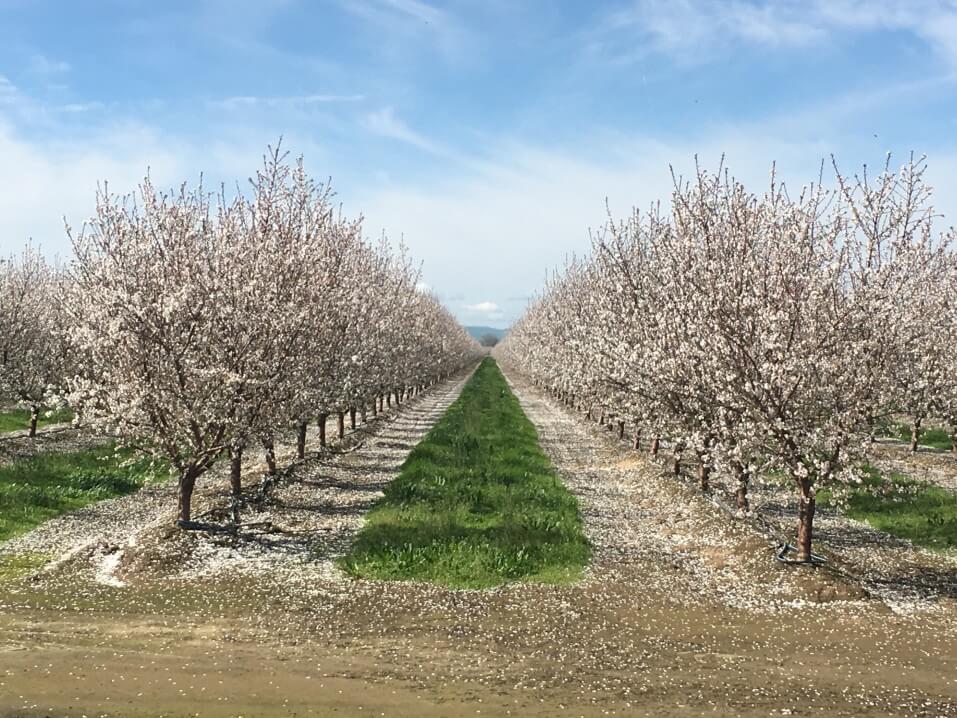As people turn to non-dairy milk for vegan reasons, health reasons, and other alternatives, they often wonder about the eco-friendliness of products like almond milk.
Today, we’re going to unpack whether or not almond milk is “bad” for the environment, and in what ways.
The truth is that almond milk production can be detrimental to the environment, in terms of water usage. However, when it comes to GHG emissions associated with its production, it isn’t as bad for the environment.
To learn more about the specifics of how almond milk production affects the environment in terms of carbon emissions, water waste, and more, keep reading.
We’re going to talk about how much water is used in the process, how it compares to the environmental effects of cow milk production, and how to be smart about almond milk production. Let’s get into it.
Why Is Almond Milk Bad for the Environment?
There are a few reasons that almond milk can be harmful to our environment.
Water Usage
The main reason that almond milk is considered “bad” for the environment is due to the water usage involved in its production.
According to a Hydrology and Earth System Sciences study, crops such as tea, nuts, and coffee all have large “water footprints”.
Pesticide Usage
The use of pesticides - like Roundup - in almond milk farming also contributes to its environmental blight.
Pesticide usage takes a toll on bees since it's deadly to them, which consequently affects the environment negatively, as bees are a crucial component in many ecosystems.
Consumer Demand
Many almond milk consumers are under the impression that it’s automatically better for the environment than dairy because it requires less land to make.
People also assume that non-dairy milk is better for the earth because there aren’t cows involved to expel large amounts of methane gasses.
But in fact, the high demand for almond milk in the consumer market actually increases the water footprint and pesticide use involved in the whole process.
When a product is popularized, especially in certain locations like California—where almonds are frequently produced—its production can take a toll on the environment.

How Much Water Does it Take to Make Almond Milk?
To break down how much water it takes to make almond milk, we have to consider the water used to farm almonds, as well as the water used in the manufacturing process.
Water Used in Farming and Production
To farm almonds themselves, it takes roughly 1.1 gallons of water to result in a single almond.
To put that into perspective, that’s 0.7 gallons more of water needed to grow an almond than what is needed to grow a single strawberry.
And when we look at how many almonds it takes to produce a single half-gallon of almond milk, it could be up to 200 almonds or more.
So when you buy a carton of almond milk at the grocery store, you’re looking at the result of roughly 200 gallons of water put to use - and that’s just to grow the almonds.
This doesn’t include the water used to clean and manufacture the final almond milk product delivered to the shelves.

The Environmental Impact of Almond Farming
The environmental impacts of almond farming spread far and wide and reach areas not limited to mere water or land usage.
Take a look at some of the many factors that impact our environment below.
Impact on Land Usage
In terms of the environmental impact of farming almonds, we can look at places like California, where the majority of almonds are grown in the US.
According to the US Department of Agriculture (USDA) in 2020, California’s “almond acreage” made up 1.6 million acres of land, which was a pretty significant (5.3%) increase from the previous year.
And since California as a state contains just 104.765 million acres of land with a large population, almond farms take up a relatively significant portion of that land.

Impact on Ground and Ground Water
Not only do almond farms take up significant land space (although arguably less compared to dairy farms); they also affect groundwater depletion.
The way that irrigation is set up for almond farms can lead to issues such as ground sinking and groundwater contamination.
Impact on Water Availability
Further, since almonds are primarily grown in California, where drought is already increasingly common, the combination of an influx in almond demand and the pre-existing water scarcity in this region leads to worsening water issues.
For example, in a region like Monterey, CA, where exceptional levels of drought exist, more than 100 gallons of water are used per person daily.
This doesn’t even include what is used for farming products such as almonds, which paints a foreboding picture of how much water we’re using to create these products despite the lack of availability of water.

Impact on Greenhouse Gas Emissions
The one environmental effect of almond farming that isn’t so severe is the emission of greenhouse gasses, which is less than what is found on dairy farms.
Impact on Ecosystems
As previously mentioned, almond farming also takes a real toll on ecosystems, especially those that rely on bees.
Because many almond farms use pesticides both during growth and post-harvest, bees are at extreme risk of getting killed off.
This impacts the overall ecosystem since many birds need bees for their diets, and an abundance of flowering plants need bees for pollination.
Essentially, the harmful effects of pesticides used on almond farms can lead to the lower reproductive success of plants and scarcity for other creatures.
Of course, the Environmental Protection Agency’s (EPA) Food Quality Protection Act has measures to protect consumers and the environment from such pesticides.
This act has “stringent safety standards”, but they only re-evaluate the safety of pesticides every 15 years.
And still, there are still some toxic pesticides that are showing up in residue on almonds - like Chlorpyrifos and Piperonyl butoxide.

Is Almond Milk Destroying the Environment?
Almond milk itself isn’t destroying the environment, but almond farming and the production of almond milk products certainly have a detrimental and growing effect on the environment.
And by taking part as a consumer of almond milk, we are contributing in a small way to a larger production process that overuses precious earth resources.
Compared to other non-dairy milk, like soy milk, for example, almond milk production uses more water. It does, however, create fewer greenhouse emissions than soy milk production does.
So you have to look at the picture as a whole.
The argument could be made that in California specifically, almond milk is destroying the environment because of how dry the region already is and how at risk the ground is there.
Almond Milk vs. Cow Milk: Environmental Impact
When we look at cow milk production and almond milk production side by side, we can see stark differences in their respective environmental impacts.
Namely, almond milk stands out as a decent alternative to cow milk in that its production emits significantly fewer amounts of greenhouse gasses.
It also requires much less land to maintain almond farms than it does to maintain cow farms.
On the other hand, though, cow milk requires far less water usage for production when compared to almond milk.
Furthermore, the detrimental use of pesticides and the effects on groundwater that we see with almond farms is not present when it comes to dairy farms.
Some people believe that the effects on water resources are more crucial than the effects on the landscape, or the greenhouse gas emissions, etc.
While many people want to draw a clear line denoting a “better” type of milk for the environment, you can’t do so without deciding which environmental factors are most important to you.
Related: Almond Milk vs. Cow's Milk
How to Reduce the Environmental Impact of Almond Milk
With all of this information in mind, consumers are often left wondering what they can do to reduce their carbon and water footprints.
The simple solution would be to not buy almond milk at all (and even cut back on homemade almond milk, as it still requires a lot of water to grow almonds).
This might mean switching to soy milk or oat milk, for example.
Check out these guides to learn how almond milk compares to soy milk and oat milk:
However, there are other ways that we can reduce the environmental impact if we still want to enjoy the dairy alternative that cuts back on carbon emissions.
These methods include:
- Buying only certified organic almond milk products that are guaranteed free of pesticides during growth and post-harvest
- Using certified organically-grown almonds when making homemade almond milk
- Being conservative with water usage when making homemade almond milk
Final Thoughts
Many consumers of non-dairy milk are concerned with the question: is almond milk bad for the environment? In truth, almond milk production uses a lot of water and sometimes pesticides compared to other non-dairy milk.
While it improves on dairy milk’s issue of excessive carbon emissions, consumers should consider buying only certified organic almond milk products or making homemade almond milk with organic almonds.
